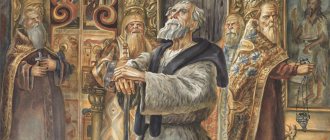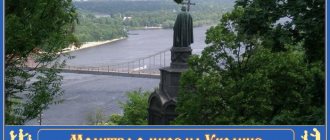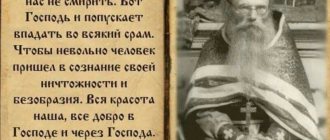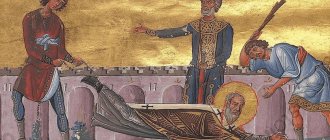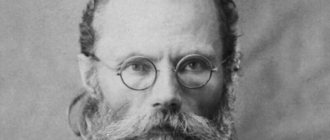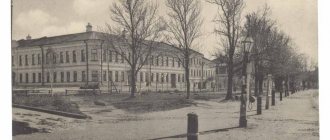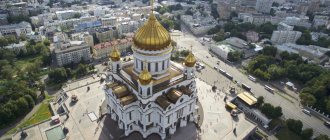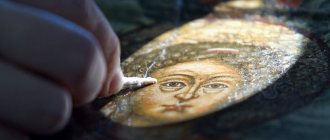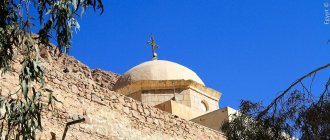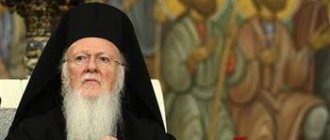What events is the name of Patriarch Nikon associated with?
Most often, when speaking about this Primate, they remember:
- an open conflict between state and church authorities, ending in the defeat of the Patriarch;
- the church schism that his reform entailed.
Only those who are interested will remember the unique New Jerusalem Monastery near Moscow. And they will think - what was (or could have become) the activity of this, apparently the most controversial of the Russian Patriarchs?
Orthodox saints named Nikon
Below we provide a list of saints named by the Orthodox male name Nikon.
Memorial days are indicated in the new style so that you can choose the boy's patron saint by the date closest to his birthday.
- Nikon (Belyaev) Optina, confessor, St. 04.02, 08.07, 24.10
- Nikon (Belyaev), archimandrite, martyr. 04.02, 10.12
- Nikon Claudiopolsky, martyr. 11.10
- Nikon Melitinsky, martyr. 20.11
- Nikon Pechersky, martyr. 09.09
- Nikon Sokolovsky, Rev. 15.07
- Nikon Sukhoi, Pechersky 11.10, 24.12
- Venerable Nikon, abbot of Kiev-Pechersk 05.04, 11.10
- Venerable Nikon, Abbot of Radonezh 20.07, 30.11
- Saint Nikon of Sicily, bishop, smch. 05.04
Contemporaries
His life came at a turning point in the country’s history:
- about a month before his birth, Tsar Boris Godunov died ; with the death of Godunov, the so-called Time of Troubles begins; it was during this period that the future Patriarch spent his childhood;
- The Nizhny Novgorod region, where the Primate’s parents lived, became the center of events; it was here that the militia of Prince Dmitry Pozharsky and Kosma Minin gathered ;
- when the future Patriarch was 8, the Zemsky Sobor elected a new dynasty - the Romanovs; 16-year-old Mikhail Feodorovich ; his father, Filaret ; he, along with his son, was written as “The Great Sovereign”; Nikon would later also receive this title under Philaret’s grandson, Tsar Alexy.
Venerable Nikon, Bishop of Sicily, commemoration date: April 5
He was born in Naples, the date of his commemoration is April 5 according to the new style. His father was a pagan, but his mother was a Christian. When the boy grew up, he decided to remain a pagan, just like his father. He entered military service and was distinguished by his strength and courage. One day he and his squad found themselves surrounded by the enemy. Then he remembered the instructions of his Christian mother. Nikon crossed himself with the sign of the cross and prayed to the Lord.
He escaped inevitable death. After returning home, he began to look for a priest, which was quite a difficult task during the time of persecution of Christians. Boarding a ship, he went to the island of Chios and climbed a high mountain, where he spent 8 days in fasting and prayer. He asked the Lord to help him. And then in a dream Saint Nikon saw an Angel who showed him the way.
Waking up, he went to Mount Ganos. Many monks hid there from the persecutors, led by Bishop Theodosius. It was from him that Nikon received Holy Baptism, and then monastic tonsure. He settled in the temple, which was located in a cave. Saint Nikon became an example for all the brethren and lived like this for three years.
| Afterwards, in a dream, the bishop had a vision of the Holy Angel, who announced that Saint Nikon should be consecrated to the rank of bishop, and then move with all the brethren to the Sicilian region. Bishop Theodosius fulfilled everything, after which he departed to the Lord. Saint Nikon was entrusted with 190 monks. Together they went on a ship to Sicily. Thus they were saved from the persecutors of Christians. By God's providence, Bishop Nikon managed to visit his native Naples. There he found his mother alive and spent the last days of her life with her. Arriving in Sicily, the saint settled in a deserted place with his brethren. Here they lived peacefully for many years, until the persecution of Christians began again. The ruler of Sicily was informed that a community of Christians lived nearby. All 199 monks (9 more people joined the 190) were captured and beheaded. Saint Nikon was left alive to be tortured: they burned him with fire, tied his legs to wild horses and forced them to drag the saint along the ground. But he remained unharmed the entire time. Then the torturers ordered him to be beheaded. His body was thrown to wild animals, but one shepherd, who was possessed by evil spirits, found his remains. Immediately he fell face down on the ground and was healed. He told all the local residents about this. The body of the saint was buried along with the murdered 199 monks. | Icon of St. Nikon, Bishop of Sicilia |
Biography
It seems that Nikita (worldly name Nikon), a peasant son, was at first very far from the political vicissitudes of the time.
Youth
When the father sent the boy to study reading and writing in one of the monasteries, he liked the structure of monastic life so much that, while still very young, he decided to become a monk. There is evidence that he literally ran away from home to the Makariev Zheltovodsky Monastery, went to all services, even spent the night in the bell tower - so as not to be late for the morning service.
Priest
The parents, having found a disobedient son, returned him home and forced him to marry. However, Nikita, presumably, persuaded them to at least agree that he, who could not imagine life without the Church, would become a lay priest. Around 1626 Fr. Nikita and his family moved to Moscow and began serving at one of the churches. When the children died one after another in 1635, he persuaded his wife to take monastic vows. And he himself retired far to the north, to the Solovetsky Monastery.
"Promise"
That's what they called the place where the monk took monastic vows. For Father Nikita, it became the Anzersky monastery of St. Eleazar. Here Nikon became a monk, tonsured by his spiritual father, St. himself. Eleazar. At first, he zealously took up ascetic work, imitating the brethren: in a day he read the entire Psalter, making up to 1000 bows.
Conflict
It happened no more than three years after the tonsure. It seemed to start with a good cause: the construction of a temple in the monastery to replace the small wooden church, which could barely accommodate 12 brethren. St. Eleazar together with Fr. Nikon visited Moscow, where they managed to collect a generous donation for a new temple. However, the monastery authorities decided that a large church was “not in the desert,” and construction stopped.
St. Eleazar took this calmly, but Fr. Nikon did not calm down and began to convince the elder to insist on the construction of the temple. Taking care of church splendor, or... violating obedience? St. Eleazar began to humble his spiritual son. After which Nikon left Solovki, going to the Kozheozersky Monastery.
Later, when the hieromonk becomes a bishop, they will reconcile with St. Eleazar. But in his spiritual son, ardent faith to the point of jealousy will be combined throughout his life with the desire to insist on his own.
Alexei Mikhailovich and Nikon in front of the tomb of St. Philip. A. D. Litovchenko, 1886
Hegumen, “lover of God”...
After only 4 years of living in the Kozheozersk monastery, the energetic hieromonk was elected abbot. It was then that he met the tsar: newly appointed abbots, according to custom, went to Moscow to introduce themselves to the sovereign. Alexey Mikhailovich appreciated the education of Fr. Nikon, and soon he became a local monastery - Novospasskaya, and with his elevation to archimandrite.
It is believed that then he entered the circle of priests, who later called themselves “God-lovers.” Seeing the spiritual crisis that had not been overcome after the Time of Troubles, and the growing influence of secular culture, zealous shepherds, who had close contact with some boyars, even the tsar himself, made plans for change. So, with their participation:
- Liturgical books and patristic works were actively published;
- for the first time in the history of the Russian Church, sermons appeared during divine services; fellow countryman o. Nikon, Archpriest Avvakum and priest John Neronov , who served at the Kazan Church on Red Square, gathered crowds of people who wanted to listen to simple, edifying words from the pulpit.
Election as Patriarch
All the endeavors of spiritual friends were shared by Fr. Nikon. The Tsar favored him; it was openly said at court that Nikon could become Patriarch after the elderly Joseph. Since 1649 it has been erected as the Novgorod Metropolis.
Vladyka Nikon received an official offer to become Primate in 1652.
Years of reign
Interesting fact
On August 4, 1652, Nikon was solemnly elevated to the Patriarchal throne. And in 1666 he was deprived of it - not at all festive.
The essence of church reform
Nikon was expected to continue the general educational line of the “God lovers.” Shortly before Lent 1653, things turned out differently...
The beginning of what is called “church reform,” although it is more correct to call it liturgical, was the Patriarchal “Memory,” sent to the churches of the capital.
The pastors were required to:
- replace the so-called “two-fingered” sign of the cross with “three-fingered”;
- cancel 12 earthly “throwings” at the prayer of St. Ephraim the Syrian - constantly repeated during Lenten services.
The fact that the Primate did not consult with the Council, but made the decision alone, caused bewilderment. There was no explanation.
But within a few months, a “right” of liturgical texts began on an unprecedented scale. It will continue until 1658. During this time, almost all the liturgical books of the Russian Church will be “corrected”. It is this, together with triplicity, that will cause a deep church schism.
Supporters and opponents of the reform of Patriarch Nikon
The first “corrected” book, the Service Book, was distributed to churches in the capital already in 1655. And it literally caused a “stupor” in many: omitted priestly and deaconal exclamations, clearly hastily made layout, and many outright errors.
“For faulty speeches” Missals will later be confiscated from churches and destroyed, after which new ones will come out of print... also “faulty”!
Former friends - lovers of God - rebelled against the Primate. For which they were immediately expelled from the capital. At one of the Councils, the bishops raised their voices - Bishops Pavel Kolomensky, Alexander Vyatsky . The first was sent to prison, where he died. Well, the signature of Bishop Alexander later appeared under the decision of the Council of 1666, which approved all liturgical changes.
Liturgists, trying to understand the reasons for the rigidity of the Patriarch and the indignation of the clergy, have now established:
- the term “correction” , which implies some kind of “damage” to liturgical texts after the Baptism of Russia, is meaningless; In the Russian Church, several liturgical Rules were initially in force (the Rule of the Church of St. Sophia of Constantinople, brought at Baptism), two monastic ones - the Studian and the Jerusalem; there were not “mistakes”, but a historically established diversity of liturgical texts;
- Nikon’s reformers - reference workers , and, as is now clear, there were a little more than a dozen of them, declared that they were making a new translation of texts from Greek into Slavic based on books contemporary with the Baptism of Russia; in fact, such ancient letters were indeed delivered to Moscow, but, as the Russian liturgist A.A. Dmitrievsky... not used! The high pace of “correction” was explained simply: Russian worship was brought into line with Greek - modern, not 10th century.
“The Journey of Avvakum through Siberia” (painting by S. Miloradovich, oil on canvas, 1898)
Archpriest Avvakum and Patriarch Nikon
A Nizhny Novgorod priest, once a friend of Nikon, is considered the leader of the resistance to the reform. His polemical works, written while in prison, were distributed in lists.
Like several other leaders of the “schism,” Fr. Avvakum was burned at the stake as a heretic on April 24, 1682. Therefore, the Old Believers now honor him as a “holy martyr.”
It is to him that the main thesis of the opponents of the reform belongs - with the change in worship, a “change of faith” occurred, therefore, the “Nikonians” are heretics.
Theological controversy
Is not it? Modern historians are well aware that the dogmas remained inviolable. It’s just that under “faith” people of the 17th century. understood not only the “set of truths”, not even so much. Faith is a confession. This is the sign of the cross, these are bows, prayers.
Let's take the “finger addition”. The outstretched “index and middle” fingers signify the union of the Divine and Human principles in Christ. And the first three connected fingers “Nikonian” are the Holy Trinity.
Is it possible to cross yourself when remembering the Crucifixion? Certainly. Is it possible to do the same, thinking that we are saved by God the Trinity? Yes too.
That is why the Local Council of 1971 declared the old and new rituals to be “equally salutary.”
But the split, provoked by completely different decisions, had long passed the “point of no return” by this time...
Orthodoxy
When the man from a peasant family turned 12 years old, the boy went to the Zheltovodsk Makariev Monastery, located on the left bank of the Volga, where he remained a novice until 1624. But at the insistence of his relatives, who lured the young man out of the service by deception, Nikita is forced to return home to his native village, where he experienced the death of his beloved grandmother and father.
Zheltovodsk Makariev Monastery
In Veldemanovo, Nikon marries and is ordained a priest. Initially, the priest conducts church ceremonies in the neighboring village of Lyskovo, but by coincidence he is sent to serve in Moscow, since the capital's merchants learned about the education and erudition of the villager. It is in the capital of Russia that the fate of the future primate of the Orthodox Church will change.
The family life of Nikita and his wife can hardly be called happy: the couple was unable to have descendants, since newborn children died in infancy. The clergyman perceived the sad losses as a sign from above, meaning removal from worldly life. So, in 1635, the priest convinced his wife to become a nun at the Alekseevsky Monastery.
Leaving money to support his wife, thirty-year-old Nikita Minin took monastic vows at the Slovetsky Monastery and became Nikon: the abbot of the monastery, Eleazar, personally performed this dedication rite. Based on the Orthodox religion, a person who has been tonsured a monk dies to his former worldly life and takes a different name, acquiring a new spiritual beginning.
Slovetsky Monastery
Detached from the hassles and bustle of life, Nikon observes a monastic life, tirelessly reads holy books and prays, devoting his will and soul to the veneration of God. Life in the monastery, located on the shores of Round Lake, was strict; the monks had to read biblical manuscripts throughout the night, without closing their tired eyes. Food in the monks’ settlement was not abundant: the hermits ate supplies of berries and fruits, and flour, which was donated by the state.
Because of his pious service and literacy, Nikon becomes the favorite novice of the Monk Eleazar of Anzersky, who in the future instructs the henchman to independently conduct mysterious liturgical rites, and Nikon is also entrusted with the management of the Scythian.
Eleazar of Anzersky
But in 1639, the monk Nikon and the elder Eleazar had disagreements regarding the construction of a new church, so the future Moscow patriarch, who did not find the support of the brethren, had to flee the monastic settlement, which he served for many years.
After his wanderings, Nikon finds solace in the Kozheozersky monastery, and after the death of the rector of the temple he becomes abbot.
In 1646, the clergyman again went to the capital of Russia to collect donations from the monastery and, according to the tradition of the ancient rite, came with a bow to Emperor Alexei Mikhailovich.
Nikon impressed the king with his education and eloquent speeches. By the way, Alexey Mikhailovich was known as a very pious man and had a condescending attitude towards the Orthodox religion and the church.
Patriarch Nikon and Tsar Alexei Mikhailovich in front of the tomb of St. Philip
After communicating with the priest, the prince realized that he wanted to see this man in Moscow, so he transferred the abbot to the capital. Some boyars did not like this attitude of the tsar towards a simple elder, but, nevertheless, a native of a peasant family becomes the archimandrite of the Novospassky Orthodox monastery.
While in service, Nikon becomes a member of the circle of “zealots of piety,” which was formed at the end of the 17th century.
Later, in 1649, Minin became metropolitan of the Novgorod diocese and fulfilled his duties with special zeal, performing services according to strictly established rules.
Bread riot of 1650 in Veliky Novgorod
In 1650, a hungry popular uprising broke out in Veliky Novgorod; the reason for the discontent of the townspeople was a sharp rise in bread prices. The participants in the riot were people of various classes, from riflemen to the poor and artisans: the Russian people opposed the policy of the sovereign. But due to the stable position of Metropolitan Nikon, who defended the interests of Alexei Mikhailovich and his other associates, the Novgorod rebellion was suppressed.
The leaders of the uprising faced a death sentence, which was later changed to merciless beating with a whip. The mitigation of punishment occurred thanks to the metropolitan, who did not remain indifferent to the worldly people: Nikon visited dungeons and listened to the complaints of the prisoners, and also communicated with the common people, which is why some townspeople found solace in the speeches of the elected metropolitan.
Church schism: start date
Usually it is considered to be 1666. There is something to argue about here. , published by church historian N.N. Subbotin (1878), clearly say: formally, no church division occurred here.
What happened? Church curse on “heretics” who cross themselves with two fingers. And then the trial of 17 “evaded” priests and monks. Of whom did not bring repentance... one person, Rev. Habakkuk. As for the rest, later widely known as the leaders of the Old Believers, the minutes of the Council irrefutably testify: they repented.
What’s alarming is that this is not the first time for most:
- repeatedly left the Church, then returned Fr. John Neronov;
- Deacon of the Annunciation Cathedral of the Kremlin Theodore came with repentance himself, accepted penance, and... every time, after a few weeks, he fled;
- Gerasim Firsov , elders Evfrem Potemkin , Sergius Saltykov repented more than once .
It would be too simple to explain what is happening as hypocrisy. The clergy were acutely aware of their break with the Church and did not want to go “into schism.” But they couldn’t stay either. Why? By answering this question, we will learn the reasons for the schism, or more precisely, the impossibility of remaining in the Church for many people who love Christ. But there is no answer yet.
"Dispute about faith." Painting by an unknown artist of the 18th century. reproduction
Reformer and "Antichrist"
The church reform, which led to a schism, did not arise out of nowhere. Centuries of disunity, political upheavals and conquests led to the fact that by the 17th century the Rite of the Russian Orthodox Church began to seriously differ from the Greek. Since the Russian people adopted the faith from the Byzantine Empire, Nikon decided to bring the rituals in the Moscow state into line with the Greek ones.
Researchers speak, however, of the Patriarch’s more far-reaching plans. It was at that time that the thesis “Moscow is the Third Rome” was finally established, and Nikon saw the sovereign of Moscow as the new emperor, himself as the Ecumenical Patriarch, and Moscow as the center of Orthodoxy, which replaced Constantinople, desecrated by the Turks. Of course, to realize such a plan it was necessary to make the Russian church rite closer to the Greek one.
In addition to revising the liturgical books and correcting errors in them made by copyists, Nikon also encroaches on such things as the “special hallelujah,” the direction of the religious procession, the clothing of the priesthood, and, finally, the sign of the cross. For most Russian people, liturgical texts were something very distant and incomprehensible; only a few literate clergy were truly indignant against the editing. But to walk in a procession of the cross against the sun, although since ancient times they walked salting, but to exclaim “Hallelujah” three times, although they always did it twice, and, finally, to be baptized “with three fingers” - it was impossible to come to terms with this. In addition, Nikon dressed the priesthood in Greek-style robes.
Maybe if Nikon and supporters of reforms had been patient and started introducing innovations gradually, everything would have passed more or less peacefully. But Nikon just didn’t have enough patience. The local Moscow Council under his chairmanship in 1656 declared everyone who crosses themselves with two fingers to be heretics and anathema. This was enough for the deaf resistance to become active. A split began. And if the supporters of the old rite were called “heretics,” then they responded by calling Nikon “the Antichrist.”
Causes and consequences of reforms
Immediately after the Council, the state decisively took a course towards “fighting schism.” Exile, prison, and the fire became the main means of “persuasion.” By the 19th century the same “struggle” moved to the pages of historical works: writing about the “schismatics” could only be accusatory, and the study of the reform itself began literally a few years before the memorable 1917.
One of the few researchers today of the liturgical changes that provoked the schism, Archpriest Georgy Krylov, writes:
“In the eyes of a medieval person, worship opened a window into the immaterial, spiritual world - a window into Paradise, and the temple was perceived as earthly Heaven. The Christian brought this liturgical-liturgical worldview from church and spread it to the rest of his life; the service continued, life turned into worship.”
That is why the change in the “rite” was perceived so acutely. But why did Patriarch Nikon decide to invade a sphere that is deeply personal for every believer - worship, reforming it at once, completely? The stated goal of the reform - a “return” to the “ideal” books of the times of the Baptism of Rus' is not confirmed by sources.
What then? Perhaps the Resurrection New Jerusalem Monastery, located near Moscow, sheds light on what is happening. The center of its cathedral church is an exact copy of the Edicule, the Chapel of the Holy Sepulcher, and in the altar is the High Place for five Orthodox Patriarchs, of which the Russian is the first. Perhaps it was not just about overcoming the worldliness that gripped Orthodox Russia after the Time of Troubles - but about transforming the country into the leader of the Christian world.
However, in an original way: through... adaptation of the Russian liturgical tradition to this very world. It’s okay that Constantinople is already called Istanbul, the Greek Missals are published by the Catholic printing houses of Venice, and the leader seems to have to set the tone, and not adapt... As once on Solovki, His Holiness did what his zeal for the Church told him to do, and also... his own understanding .
The consequences of what happened are well known:
- the irreparable human losses of the Church - according to modern estimates, up to 30% of believers have left it;
- a colossal decline in the authority of the Church.
Venerable Nikon, Abbot of Radonezh, commemoration date: July 20, November 30
Another saint is the Monk Nikon, abbot of Radonezh, the dates of his memory are July 20, November 30 according to the new art. He was born in Yuryev-Polny. Having heard about the life of St. Sergius of Radonezh, he came to him with a request to tonsure him as a monk. The Monk Sergius gave him a test - he ordered him to go into obedience to his student Afanasy Vysotsky. But he did not immediately accept Nikon. As soon as he was convinced of the seriousness of his intentions, he tonsured him as a monk.
Saint Nikon diligently practiced prayer and reading Holy Scripture. After reaching adulthood, he was ordained to the priesthood. The Monk Sergius blessed him to serve the brethren. Six months before his death, he appointed Saint Nikon as his successor.
After the death of the elder, Saint Nikon with great love and care supported everything that was arranged by the Monk Sergius. He worked equally with the brethren and attended all monastery services.
But his soul always yearned for solitary prayer, so he decided to leave his abbotship and began to live as a recluse in one of the cells. For 6 years the monastery was led by the Monk Savva of Storozhevsky, but in 1400 he founded his own monastery. The brethren turned with prayers to the Monk Nikon. They asked him to return to them as abbot. Saint Nikon agreed.
At this time, rumors began to spread about the invasion of Rus' by Khan Edigei. The Monk Nikon prayed intensely for the preservation of the monastery. The appearance appeared to him in a subtle dream so that he would not grieve over the destruction of the monastery.
Icon of St. Nikon, Abbot of RadonezhAfter this, a decision was made for all the monks to leave the monastery, taking with them only their cell belongings and shrines. After returning back, they saw that their monastery had turned into ashes.
But the Monk Nikon instructed the brethren not to become despondent. They began new labors and restored their beloved monastery. While digging a ditch to build a stone church, the incorruptible relics of St. Sergius were discovered.
To decorate the new temple, Nikon invited the best icon painters, monks Andrei (Rublev) and Daniil (Cherny). It was here that the icon of the Life-Giving and Most Holy Trinity was painted by St. Andrew.
Until the end of his days, the Monk Nikon took care of the brethren. Before his death, he had a vision of his resting place. He gathered the monks and gave the last instructions. Having received the Holy Mysteries of Christ, he peacefully departed to the Lord.
He was buried next to the shrine in which the relics of St. Sergius of Radonezh rested.
Quarrel with the king
The secular authorities did not share Nikon’s ideas about Russia as the world center of Orthodoxy. Maybe because it was based on the principle of “priesthood above kingdom”? But the patriarchal title is unprecedented in Russian church history:
“By the grace of God, great lord and sovereign, Archbishop of the reigning city of Moscow and all great, small and white Russia and all northern countries and Pomoria and many states, Patriarch.”
The fate of the “great lord and sovereign” was not the best:
- , 1658 he, after another quarrel with the sovereign due to constant interference in the affairs of secular authorities, left the department, leaving for his beloved New Jerusalem Monastery; I waited for them to call me back, but they didn’t;
- On December 22, 1666, in the presence of the Ecumenical Patriarchs, the Local Council (the same one that condemned the opponents of the reform!) not only deprived the Primate of the department, but removed him from the bishopric, moreover, expelled him from the priesthood; In subsequent years he was “Monk Nikon.”
The trial of Patriarch Nikon (S. D. Miloradovich, 1885)
Personal life
During his lifetime, Patriarch Nikon was an educated and well-read man who amazed not only with his thorough knowledge of the Holy Scriptures, but also with his worldly wisdom. It is difficult to judge Nikon’s personality, since Old Believers and supporters of new reforms characterize this person differently. Some write in their biography that Nikon is the wisest Orthodox figure, whose reforms were beneficial; others believe that Minin is a power-hungry, greedy and cruel person who was ready to do anything to gain the favor of the king.
Monument to Patriarch Nikon in Saransk
When the judges removed Nikon from office, the panel cited a summary of all the “crimes” of the patriarch, and this is what was written in that manuscript:
“Nikon, without any conciliar consideration, personally deprived Bishop Pavel of Kolomna of his rank, became furious, pulled off Paul’s mantle, and handed him over to severe plagues and punishments,” which is why Paul lost his mind and the poor man died: either he was torn to pieces by wild beasts, or he fell into the river and died. ."
However, none of the historians can judge the reliability of this information.
Disgrace and death
There followed an exile to the Ferapontov Monastery, then to the Kirillo-Belozersky Monastery. The new king, Theodore Ioannovich, allowed him, already seriously ill, to return to New Jerusalem. Death overtook him on the way, August 27, 1681.
Tsar Feodor Alekseevich, who personally loved Nikon, insisted that he be buried as the Primate. He himself read the Apostle, Psalm 118, over the tomb.
On May 5, 1682, Patriarch Jacob of Constantinople, also at the request of the Russian Tsar, sent a letter of permission:
“Reverend of memory, our beloved brother, Mr. Nikon, former Patriarch of Moscow and All Russia, instead of retribution and bribery, testimony for the sake of long reverence and patience, has forgiveness and permission from the conciliar eruption that happened to him, and may he be forgiven in the present age and in the future from the Father and the Son and the Holy Spirit, the Holy and Life-Giving Trinity; having received the spiritual tunic of the bishopric, may he, like a patriarch, always receive church commemoration, commemorate with the other patriarchs of Moscow in sacred diptychs, and at all named times of sacred church successions, without a doubt, may he be combined in reality with the number of other patriarchs of Moscow, the patriarch; what is revealed and named and remembered, not a single one will resist, truly so be it!
By the same token of justification this forgiveness was issued».
“Long veneration and patience” apparently became the main work of “Monk Nikon” in the last years of his life. But they remained in obscurity.
Patriarch
In 1649, Nikon was elevated to the rank of Metropolitan of Novgorod and Velikolutsk. Here he showed himself to be a wise statesman and, by all accounts, superbly demonstrated his energy and intelligence during the riot that occurred in Novgorod in 1650. Nikon did everything to quell the rebellion in the bud without excessive cruelty.
Patriarch Joseph died in 1652. The Emperor wanted to see Nikon on the Patriarchal throne. He resolutely refused. And then an incredible scene happened. In the Assumption Cathedral, in front of a large crowd of people, Alexei Mikhailovich fell at the feet of the son of a Mordovian peasant and, shedding tears, begged him to accept the Patriarchal dignity. After everyone else prostrated themselves after the king, Nikon gave his consent. However, at the same time, he took an oath from the king and all those present that they would obey him in everything in matters of faith. The Tsar, the boyars and the people took such an oath. This is how the vision of the Anzer elder Eleazar came true.
Nikon founded several monasteries: the Iversky Monastery on Lake Valdai, the Onega Cross Monastery on Kiy Island and Nikon’s most famous brainchild - the New Jerusalem Monastery, which he conceived as nothing less than the center of the Orthodox world and a repetition of the Church of the Resurrection of the Lord in Jerusalem.
He returned to church life the custom of preaching from the pulpit, abolished polyphony (the simultaneous performance of several chants, differing in words and melody), which made church services completely incomprehensible to the flock, and began to “correct” church books.
